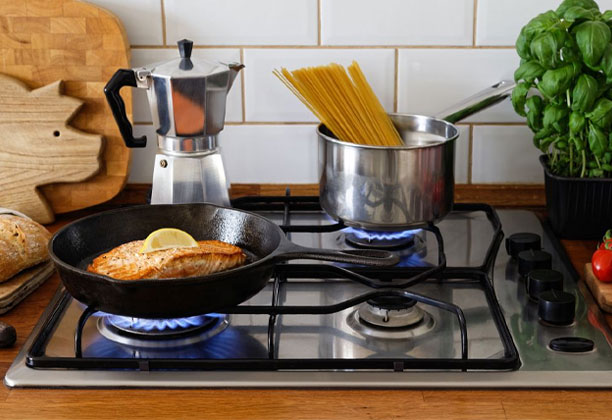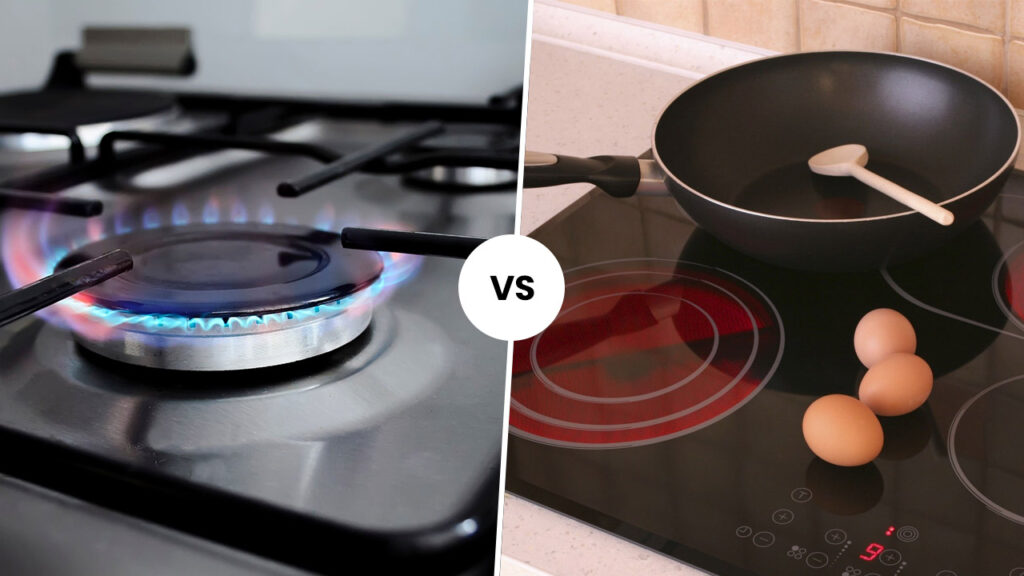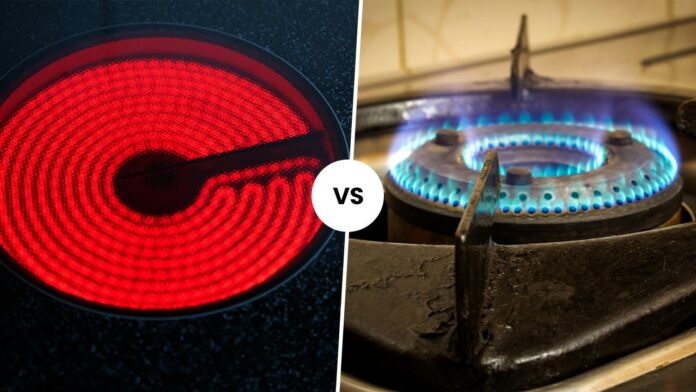Introduction
When it comes to upgrading your kitchen or remodeling the kitchen for aesthetic appeal, there are several important factors to consider to ensure a successful outcome. The kitchen is one of the most frequently used rooms, and choosing the right stove type is an important part of the remodeling process as it can greatly improve its functionality and efficiency.
In this article, we’ll take a closer look at both electric and gas stoves, weighing the advantages and disadvantages of each so you can make an informed decision that suits your needs and lifestyle.
What Are Gas Stoves?

A gas stove is a stove that burns combustible gas, such as syngas, natural gas, propane, butane, liquefied petroleum gas, or other flammable gas. Cooking stoves previously used solid fuels like coal or wood before the invention of gas.
Standing pilot and electric ignition sources are the two main types of ignition sources used by gas stoves nowadays. Under the cooktop of a stove with a standing pilot is a tiny, continually burning gas flame known as a pilot light. The flame is situated halfway between the front and back burners. This flame ignites the gas emitted by the burners when the stove is turned on. The standing pilot system has the benefit of being easy to use and totally independent from any external power source.
Pros And Cons Of Gas Stoves
Pros
1. In most states, gas can be more affordable than electricity.
2. Quick switching of the temperature from high to low
3. Stove and oven heat more quickly
4. More adaptable for searing, grilling, and simmering
5. It’s significantly simpler to regulate temperature
6. It’s simpler to wipe the stovetop.
7. Compatible with a wide range of pots and pans
Cons
1. The process of switching them on is not as failsafe as that of an electric stove.
2. The flame on the burner won’t always ignite in all cases.
3. The pilot light is extinguished
4. The burner flame may be of low intensity.
5. There may be difficulties with the ventilation
6. Gasoline has the potential to produce a greasy film.
What Are Electric Stoves?

An electric stove or electric range is a type of stove that has an integrated electrical heating unit that can be used for cooking as well as baking. Electric stoves quickly became the more popular option, which led to their replacement of solid-fuel stoves, which took more effort to operate and maintain over time. There are certain modern stoves that come bundled with an extractor hood that is incorporated.
Pros And Cons Of Electric Stoves
Pros
1. With an electric stove, the kitchen remains cooler
2. A cooktop has a flatter surface to be cleaned.
3. For pots, the flatter surface is more stable.
4. They’re simpler to switch on and off.
5. There are likely already 220 volts installed in your kitchen.
6. They might be cheaper and easier to install.
Cons
1. You can’t tell if it’s on, making it easy to burn yourself
2. The gas price can be higher for newer vehicles with complex features.
3. Electric stoves require around three times as much energy as gas burners.
4. If the power goes off, the stove also does.
5. If an object is dropped on a cooktop, it may be harmed.
6. They heat up food more slowly than gas
Types Of Material Available In Electric And Gas Stove
Stainless Steel
Stainless steel stoves are a great option for both gas and electric stove users due to their durability, easy maintenance, and attractive appearance. They also offer excellent heat conductivity and resistance to food reactions, ensuring that they perform well and look great for years to come.
Tempered Glass For Glass top
Glass top stoves are a popular choice for the kitchen since they provide a flat and smooth surface that is easy to clean, even heat distribution for consistent cooking results, and a sleek and modern appearance that complements any kitchen design.
One of the main advantages of using a tempered glass gas stove is that it is compatible with various cookware and easy to clean and maintain. However, there are several disadvantages to glass top gas stoves too. They have a brittle surface that can crack or shatter if subjected to sharp impacts or extreme temperature changes.
Whereas electric stoves made out of tempered glass help to distribute heat evenly, leading to more consistent cooking results. Also, the stove remains cooler to the touch, reducing the risk of accidental burns.
Aluminum
Aluminum is ideal for gas stoves because it is good at transferring and distributing heat. However, aluminum is relatively soft, light, and prone to warping when exposed to high heat in its pure form. It is also quite sensitive to acidic foods and easily scratched. Because of this, metal is frequently anodized.
Cast Iron
Many homes rely heavily on cast iron stoves as a source of heat. It keeps the heat longer than conventional wood-burning stoves and heats rooms rapidly and effectively. Longer lengths of time are now possible for the remaining heat to be released into space.
Copper
Copper gives your stove more than simply style; it also assists you in the kitchen. The finest feature about copper as a conductor of heat is that it warms up rapidly and maintains its warmth, allowing for an even distribution of heat and, the best part, uniform cooking of your food.
Gas Vs Electric Stove | A Detailed Analysis

Appearance
A gas range offers a kitchen an elegant appearance. It frequently serves as the room’s focal point and gives away the presence of a passionate cook. A gas range, however, might appear unkempt and is more difficult to maintain.
In contrast, an electric range with a smooth glass top is more modern-looking, cleaner, and sleek. Because of this, it appeals to everybody who wants a clean kitchen.
Installation
Gas stoves need a gas line in the building and are challenging to install. They present the risk of fires caused by gas leaks. Also dangerous is putting young children near an open flame.
An electric stove will not work if the power is out. Pots are difficult to stabilize while cooking due to the spiral form. There are now smooth-top stoves on the market, which offer greater counter space and better stability while using pots. But the isolation is easier and cheaper than gas stoves.
Performance
More people have used gas stoves than electric stoves for a significantly longer period of time. Gas stoves’ flames can be quickly and precisely controlled for heat. Faster and more consistent cooking is made possible by the pans’ evenly distributed heat on the sides and bottom. A cooler kitchen is the result of less overall heat generation.
With an electric stove, the heat usually lasts long after the burner is dimmed or turned off. Cooking that is delicate now presents a challenge. But using an electric stove for baking and roasting is preferable.
Cost
Compared to electric stoves, gas stoves are often more expensive to purchase but less expensive to use. Gas stoves are not only cheaper to operate than electric stoves, but they are also more energy efficient.
A gas stove burns fuel such as propane, butane, natural gas, liquefied petroleum gas, or other combustible gases, whereas an electric stove heats coils with electricity.
Safety
When it comes to the issue of safety, there is no contest: electric stoves come out on top every time. Cooking using an electric stove poses no risk of fire, unlike using an open flame. When it comes to gas stoves, the possibility of gas leaks can result in a fire breaking out. An open flame is dangerous not only for children but also for animals.
Cleaning
Both electric and gas stoves can be simple to clean, depending on the type of surface and design. Electric stoves with smooth ceramic or glass cooktops are usually easier to clean, while electric stoves with coil elements can be more challenging to clean. On the other hand, gas stoves with sealed burners are generally easier to clean, while open-burner gas stoves can be more difficult.
Which Is Better Electric Or a Gas Stove?
Is gas or electric stove better? This question cannot have a definite answer since both have their pros and cons.
Gas stoves have the potential to be the most user-friendly of all types of cooking appliances. Even while electric stoves can occasionally heat up more quickly than gas stoves, cooks can more quickly and easily adjust the heat level with a gas burner by turning the flame up or down. Additionally, even after you turn off the heat, electric stove burners have a tendency to retain heat longer, so if you leave a pot on the stove, it may continue to cook and eventually burn.
Although the cost of gas and electric stoves may be roughly comparable, users will ultimately save money because of the typical gas stove’s high level of energy efficiency. Therefore, feel free to experiment in the kitchen while going green.
Final Thoughts
When looking for a new stove and deciding between gas and electric models, it is important to choose the one you will feel the most at ease operating. Choose an electric stove if you have doubts about using natural gas or if you find the idea of preparing food over an open flame unsettling. On the other hand, if you are concerned about your finances or if you are a novice cook, gas can be your best option. Your decision is, of course, the one that ultimately matters.

















